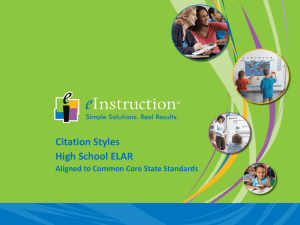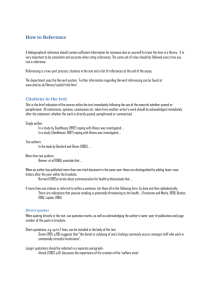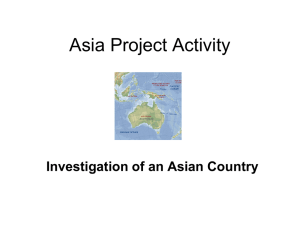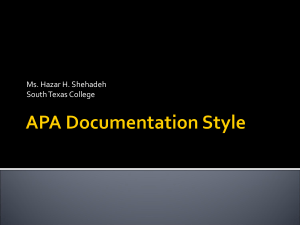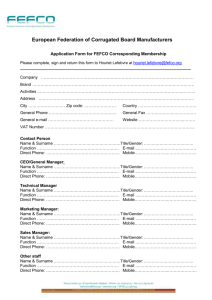Word template
advertisement
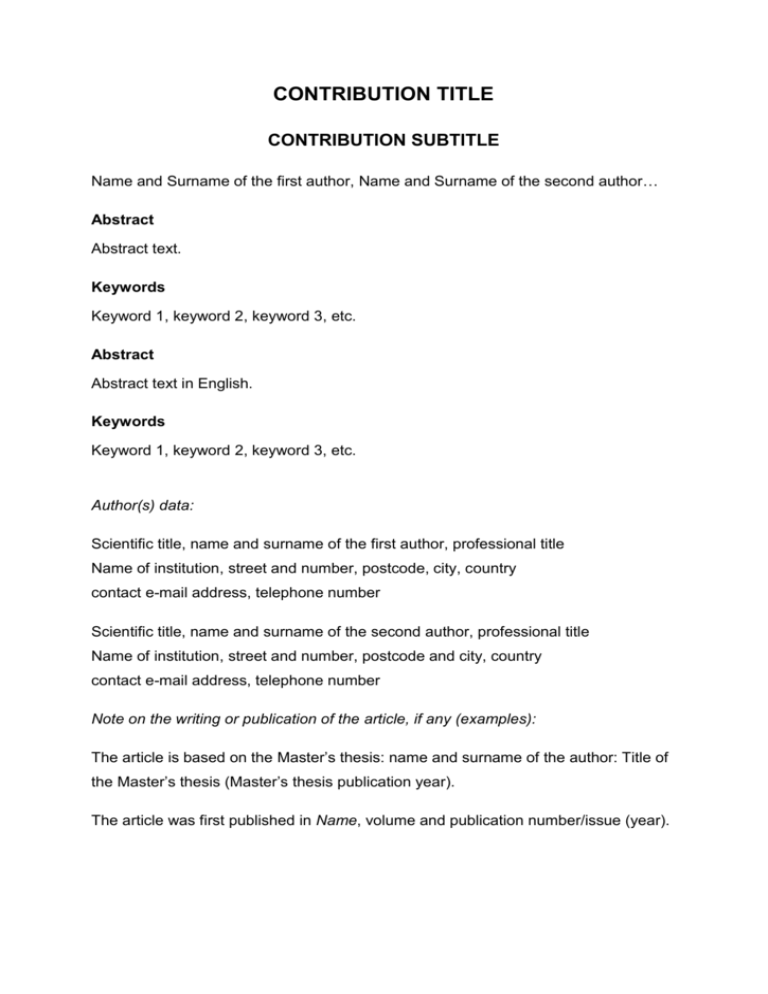
CONTRIBUTION TITLE CONTRIBUTION SUBTITLE Name and Surname of the first author, Name and Surname of the second author… Abstract Abstract text. Keywords Keyword 1, keyword 2, keyword 3, etc. Abstract Abstract text in English. Keywords Keyword 1, keyword 2, keyword 3, etc. Author(s) data: Scientific title, name and surname of the first author, professional title Name of institution, street and number, postcode, city, country contact e-mail address, telephone number Scientific title, name and surname of the second author, professional title Name of institution, street and number, postcode and city, country contact e-mail address, telephone number Note on the writing or publication of the article, if any (examples): The article is based on the Master’s thesis: name and surname of the author: Title of the Master’s thesis (Master’s thesis publication year). The article was first published in Name, volume and publication number/issue (year). TITLE 1 Title 1 (first level) is unnumbered. It is recommended to divide the title up to three levels (Title 3). The title is followed by text with 1.5 line spacing in Arial 12 point font. Title 2 Title 2 (second level) is unnumbered. It is recommended to divide the title up the three levels (Title 3). Followed by text. Title 3 Title 3 (third level) is unnumbered. It is recommended to divide the title up to three levels (Title 3). Followed by text. Citations should be visually separated from the rest of the text. For short citations (up to 40 words), use double inverted commas. For longer citations (40 words or more), use double inverted commas; the text should appear in a separate paragraph. Example of a short or inserted citation: Text. "Citation text. Citation text. Citation text. Citation text. Citation text. Citation text. Citation text. Citation text. Citation text. Citation text. Citation text. Citation text. " (author, year, p.) Text. Text. Example of a longer or separate citation: Text. Text. Text. Text. Text. Text. Text. Text. Text. Text. Text. Text. Text. Text. »Citation text. Citation text. Citation text. Citation text. Citation text. Citation text. Citation text. Citation text. Citation text. Citation text. Citation text. Citation text. Citation text. Citation text. Citation text. Citation text. Citation text. Citation text. Citation text. Citation text. Citation text. Citation text. Citation text. Citation text. Citation text.« (author, year, pp.) Text. Text. Text. Text. Text. Text. Text. Text. Text. Text. Text. Text. Numbered or unnumbered lists can be included in the text. Example of a numbered list: 1. text 2. text Example of an unnumbered list: text text Figures should be placed appropriately within the text. Figures should be named »Figure«, numbered, and given a caption. Figure captions should be placed below the figure. All figures should be referenced by entering »(Figure 1)« after the text, or referenced in the body of the text, e.g. »Figure 1 shows…«, etc. It is recommended to use automatic numbering for figures, which is not related to the numbering of chapters. Figures are all graphic representations, such as graphs, photographs, various diagrams, etc. Figures should not have borders. The source of the figure (author, year) should be written in brackets after the figure caption. All sources used should be listed in the reference list at the end of the article. 1. Figure 1: Short description or figure caption (source: IZUM, 2012) Tables should be placed appropriately within the text. All tables should be named »Table«, numbered, and given a caption. Table captions should be placed above the table. All tables should be referenced by entering »(Table 1)« after the text, or referenced in the body of the text, e.g. »Table 1 shows…«, etc. Symbols, abbreviations, and non-standard units of measurement used in tables should be defined in a legend. The legend should be placed below the table. The source of the data should also be listed below the table. All sources cited must be listed in the reference list at the end of the article. It is recommended to use automatic numbering for tables, which is not related to the numbering of chapters. You can define cell borders; it is recommended to use horizontal lines only as tables without vertical lines are clearer. Table 1: Short description or table caption Libraries in the COBISS.SI system 2009 2010 2011 2012 2013 National, university and academic 74 76 82 84 81 Public 60 61 61 61 61 Special 124 121 125 128 126 School 132 141 152 159 165 Total 390 399 420 432 Legend: COBISS – Cooperative online bibliographic system and services 433 Source: IZUM (2014) Footnotes Footnotes must not be used. Literature Harvard citation style (author-date system) should be used for in-text citations and the reference list at the end of the article. Following the Harvard citation style, the following referencing rules should be applied: When referencing a source or an author, the author’s surname and the year of publication separated by a comma should be inserted in round brackets. Example: (Tapscott, 2009) If the author’s name is referenced in the text, only the year of publication should be inserted in brackets after the author’s name. Example: In a study, which is the result of student population research in the USA, Robert Kvavik (2005) determined that… If a work has two authors, both authors should be cited; the names should be joined with the word »and«, followed by the year of publication, separated by a comma. Example: (Šuster and Dinevski, 2011) If a work has three or more authors, only the surname of the first author should be provided, to which the abbreviation et.al and the year of publication should be added; the data should be separated by commas. Example: (Griffin, et al., 2014) If you cite a work with an editor as a whole (e.g. conference proceedings), add the abbreviation ed., followed by a comma and the year of publication. Example: (Knežević ed., 2014) If you use a direct quote (citation), the page number (p.) where the quote can be found should be provided after the author's surname and the year. The data must be separated by commas. Example: (Božič, 2013, p. 43) If you cite several pages from the same work, the pages (pp.) must be separated by commas. Example: (Božič, 2013, pp. 36–37, 39–41) If you cite multiple works by the same author with different years of publication, provide the author's surname and years of publication in chronological order starting with the earliest; the years must be separated by semi-colons. Example: (Steinbuch, 2011; 2013) If you cite multiple works by the same author with the same year of publication, use lower case letters in alphabetical order next to the year of publication; the years must be separated by semi-colons. Example: (Steinbuch, 2011a; 2011b) If you cite multiple works by different authors, list the data in chronological order starting with the earliest; use semi-colons to separate the data. Example: (Kovač and Šauperl, 2005; Južnič, 2010) If you cite multiple works by different authors, but some of those works have the same year of publication, list the data in chronological order starting with the earliest, separate the data by semi-colons and, additionally, sort it in alphabetical order. Example: (Breeding, 2012; Bojanc, 2013; Markelj and Zgaga, 2013; Pirnat, 2013; Shelton, 2013) If the author is unknown, list the title of the work or the first few words of the title, and the year of publication. Example: (Information literacy, 2008) When a corporation or an organisation is the author of the work (corporate author), the name of the corporation or organisation and the year of publication should be provided. Standard abbreviations for corporations or organisations may be used, in which case the full name of a corporation or an organisation must be written when used for the first time, and the abbreviation must be provided in brackets. The full name of the corporation or organisation (corporate author) must be listed in the reference list at the end of the article. Example: Recently, the International Federation of Library Associations and Institutions (IFLA, 2012) issued guidelines… Example: IFLA (2012) published… Example: (IFLA, 2012) If the year of publication is unknown, use the common abbreviation s.a. Example: (Znanstvena knjižnica, s.a.) When citing laws and regulations, provide the acronym of the law or regulation and the cited article. Example: (ZKnj-1, Article 44) When citing a quote from an online source, the same rules for in-text citing as for print sources apply. If authorship is not evident, provide the copyright holder. You can find the date of publication at the bottom of the webpage (copyright) or in the title. Example: (IZUM, 2011) As a rule, only primary or original sources should be cited; avoid citing secondary sources or using indirect citations, summarising, and paraphrasing (»quoted in«, abbreviated »qtd. in«). When the primary source is unavailable, however, you may use indirect citing. When using indirect summarising, the source should be referenced as follows: (primary author’s surname, year qtd. in secondary author’s surname, year, pp. first page–last page). In the reference list, only the works that were used (read) should be listed; in the case of indirect citing, only the reference for the secondary author or the bibliographic record of the publication, where the citation was taken from, must be listed. When citing literature (books, articles, proceedings, etc.) and resources (internet addresses, dictionaries, laws, etc.) or references, all the works that you used when writing the contribution should be listed at the end of your contribution, which must be clear from the contribution. In-text citing must correspond to the reference list at the end of the contribution. In other words, all sources cited within the text must be listed in the reference list and vice versa. The literature used must be listed in the References chapter in alphabetical order by the surname of the first author, or title, if the author is unknown. Sources should not be numbered, and no bullets should be used. Sources should be listed in paragraphs. At the end of the contribution, after the References chapter, you may, in some cases, also add the Further reading chapter, which includes a list of other resources for which the author thinks that the reader might find interesting. The Further reading chapter may not be included in scientific or professional articles but only in other types of contributions such as reports and other articles, etc. Using the Harvard referencing system, the following general rules must be applied when listing references at the end of a contribution: List the author as follows: Surname, Initial letter of the first name. After the initial letter of the first name of the editor or multiple editors, the abbreviation ed. should be added: Surname, Initial letter of the first name, ed. If there are two authors, the word and should be written between the authors. If there are multiple authors (up to six), all authors, as they are indicated on the publication, should be listed; authors should be separated by commas; before the last author, the word and should be written. If there are more than six authors, list the first six, separated by commas, followed by et al. If the author or editor of the publication is unknown, sort the publication by title. If the publication was written by an organisation, not by an individual, the organisation should be listed as the author (corporate author). Titles of books and journals must be written in italics. In the title of books, articles, chapters, etc. only the first word and names should be written with a capital letter. Data on the edition should be included only if it is not the first edition; it should be listed in the language of the publication. If only a part of the publication is cited, the data on the chapter and pages should be added at the end, after all the bibliographic data. The pages of the contribution should listed for articles, conference proceedings, book chapters, etc. For electronic publications, the type of medium should be stated in square brackets after the title; e.g.: [CD-ROM], [DVD], [e-book], [e-newspaper], [ejournal], [online], etc. If the publication is available online, provide the URL (Uniform Resource Locator) after the publisher, and the date of access in square brackets. Internet addresses or URLs must be active (underlined). If the publication has a DOI (Digital Object Identifier), provide the DOI at the end of the bibliographic unit. General bibliographic data should be written as follows for: a book with one author Author's surname, Author's first name initial., Year of publication. Title: subtitle. Edition, if not first. Place of publication: Publisher. a book with two authors Author's surname, Author's first name initial. and Author's surname, Author's first name initial., Year of publication. Title: subtitle. Edition, if not first. Place of publication: Publisher. a book with multiple authors Author's surname, Author's first name initial., Author's surname, Author's first name initial., Author's surname, Author's first name initial., and Author's surname, Author's first name initial., Year of publication. Title: subtitle. Edition, if not first. Place of publication: Publisher. a contribution or a chapter in a book Surname of the author of the chapter, Author's first name initial., Year of publication. Title of the contribution or chapter. In: Surname of the author (editor or publisher), first name initial. ed. Title of the book: subtitle. Place of publication: Publisher. Pages (pp. first page–last page) or chapter number (Ch.). an e-book Author's surname, Author's first name initial., Year of publication. Title. [medium type] Edition, if not first. Place of publication: Publisher. If the e-book is available online, the following data should follow the data on the publisher: Available at: title of the webpage or source, and web address or URL [Date of access]. several works by the same author with the same year Author's surname, author's first name initial., Year of publication, lower-case letter a. Title. Place of publication: Publisher. Author's surname, author's first name initial., Year of publication, followed by lowercase letter b without a space. Title. Place of publication: Publisher. a contribution in proceedings Author's surname, author's first name initial., Year of publication. Title of the contribution. In: Editor's surname, first name initial. ed. Proceedings title. Place of publication: Publisher. Pages of the contribution (pp. first page of the contribution– last page of the contribution). an article in a journal Author's surname, author's first name initial., Year of publication. Article title. Journal title, Volume number(issue number), pages of the contribution (pp. first page of the article–last page of the article). an article in an e-journal Author's surname, author's first name initial., Year of publication. Article title. Journal title, [medium type] Volume number(issue number), pages of the contribution. If the e-journal is available online, the following data should be provided: Available at: internet address of the webpage and URL [Date of access]. an article in a journal from a database Author's surname, author's first name initial., Year of publication. Article title. Journal title, [medium type] Volume number(issue number), pages of the contribution. Available at: The name of the online database or resource, internet address or URL [Date of access]. a diploma thesis, a Master's thesis or a doctoral dissertation Author's surname, author's first name initials, Year of publication. Title: subtitle. Diploma thesis/Master's thesis/Dissertation. Place of publication: University, Faculty. Official documents (laws, regulations, rules) Title (abbreviation of a law or regulations), Year of publication. Publisher/Bulletin and number. websites Author or source, Year of publication. Title of the webpage or online document. [medium type] (Date of update, if available) Available at: internet address or URL [Date of access].

